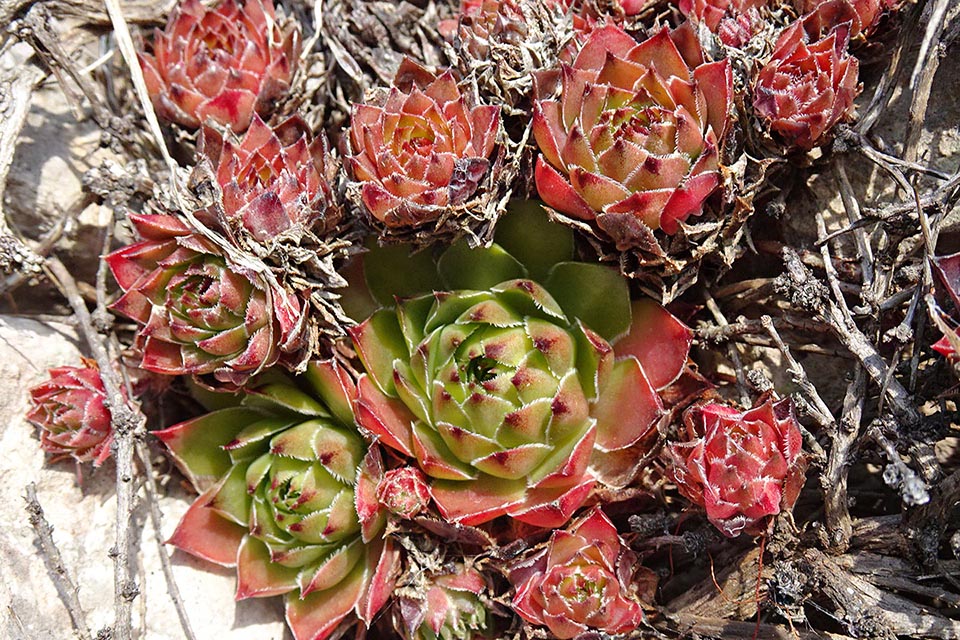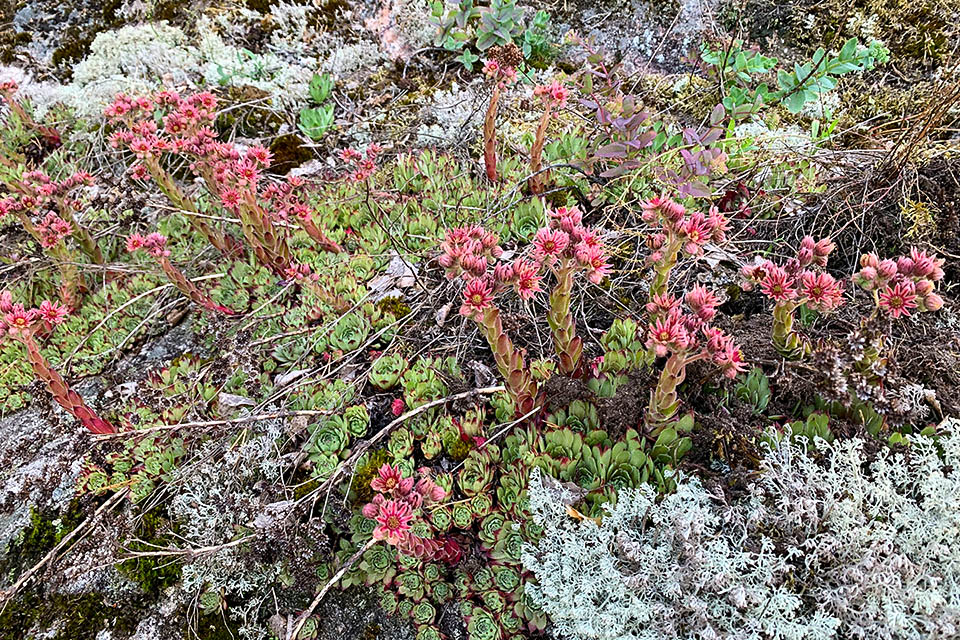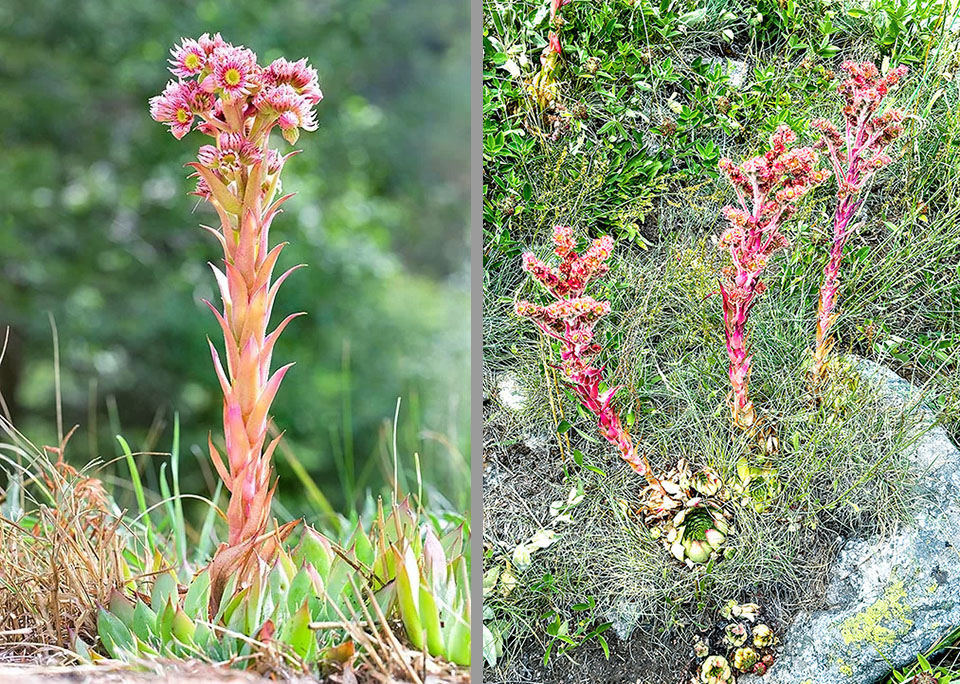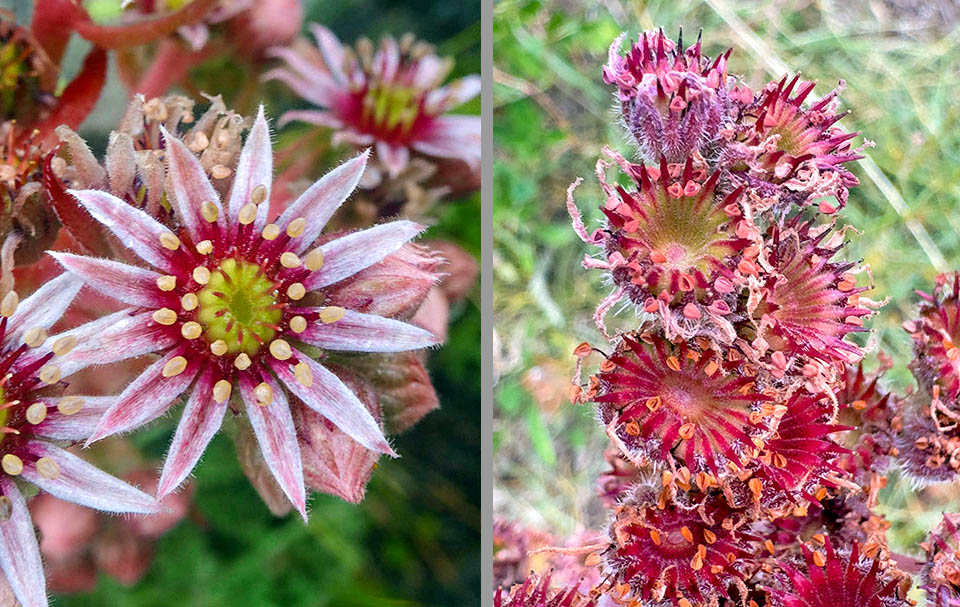Family : Crassulaceae

Text © Pietro Puccio

English translation by Mario Beltramini

Native to Morocco and most of Europe Sempervivum tectorum is a succulent species with basal rosettes with 50-60 persistent and alternate leaves © Alba Rovira
Sempervivum tectorum L. (1753) is native to Europe (Austria, France, Germany, Hungary, Italy, Montenegro, Poland, Serbia, Slovenia, Spain, and Switzerland), where it grows on the Alps, Apennines and Pyrenees, in the grasslands and on stony, mainly siliceous, rocks and soils, in particularly arid and sunny situations, up to about 2.800 m of altitude.
The name of the genus is the combination of the Latin words “semper” = always and “vivum” = alive, with reference to its survival capacity in climatically hostile habitats; the name of the species is the Latin word “tectorum” = of the roofs (from “tectum”), with reference to its facility to grow on the tiled roofs.
Common names: common houseleek, hens and chiks, houseleek, roof houseleek (English); čuvarkuća (Croatian); artichaut des murailles, grande joubarbe, herbe de tonnerre, joubarbe des toits (French); barba di Giove, guardacasa, semprevivo dei tetti, semprevivo maggiore (Italian); sempre-viva-dos-telhados (Portuguese); navadni netresk (Slovenian); alcachofa de gatos, barba de Jupiter, consolva, hierba puntera, siempreviva mayor, zurracallote (Spanish); Hauswurz, Dachwurz, Dach-hauswurz, Dach-rose (German); fali kövirózsa (Hungarian).

Grows in pastures, rocks and stony soils, mainly siliceous, in particularly arid and sunny situations, up to about 2800 m of altitude © kaluste
Sempervivum tectorum is a much variable, succulent, perennial, stoloniferous, which forms compact tufts, monocarpic (it blooms only once, then dies), with 50-60 persistent succulent leaves, alternate, united in a basal rosette rather open, 4-10 cm diameter.
The leaves are sessile (without petiole), obovate-oblong with mucronated apex (that is, equipped with a short, thin, point similar to a thorn), 3-5 cm long and 1-1,5 cm broad, glabrous or slightly downy with ciliate margins, of green colour with reddish brown extremity.
Summer inflorescences in terminal cymes on a 15-40 cm tall scape carrying 10-40 flowers, and even more, which can reach 3 cm of diameter, each one with 10-15 lanceolate, pink to purple, petals, with a darker central band, also 1-1,2 cm long, pubescent externally.
The floral scape is provided of oblong, imbricate, slightly pubescent, leaves, of a green colour suffused with red, more intense on the extremity, up to about 4 cm long.

The summer inflorescences, on a 15-40 cm stem, may appear compact with few flowers or widened with even 40 elements © Giuseppe Mazza
The fruits are follicles containing several tiny seeds. After the fructification, as we have already briefly said, the rosette dies and is replaced by the near ones. It reproduces by seed, placed on the surface, which germinates in 2-4 weeks, or more, at a temperature of 20 °C, and, very easily, by division.
Sempervivum tectorum is an extremely variable plant, as the numerous synonyms show, which also hybridizes quite easily and of which many varieties have been selected, which distinguish mainly for the colour of the rosette. It resists to the low temperatures, as low as -30 °C, as well as to the high ones and to long drought periods due to the intense insolation they are submitted in summer. Plant suitable for rock and alpine gardens, as ground cover, between the cracks of the stones and for edges; it often grows spontaneously on the walls and on the tiled roofs in full sun and on much draining substrata, possibly acid, but adapting also to calcareous soils. It is often cultivated in pot, in particular in its numerous varieties, by the lovers of succulents, at the maximum possible luminosity and with substrata added of sand or crushed stones, possibly siliceous, up to the 50%.

In this case the flowers that may reach a diameter of 3 cm, are obviously smaller © Ben Costamagna (left) and © Giuseppe Mazza (right)
It needs more humidity at the time of the vegetative renewal, in spring, and till mid summer, then regular watering, but always allowing the substratum to dry up for some days before irrigating again, then watering are to be reduced and finally to be almost suspended in winter.
Sempervivum tectorum has been variously utilized by the local populations in the traditional medicine, especially for compresses against burnings, skin ulcerations and insects’ stings, and also, when growing on the roofs, was deemed to protect the house from the thunderbolts and the witchcrafts.
Synonyms: Sedum majus Garsault (1764); Sempervivum clusianum (Ten.) Ten. (1830); Sempervivum glaucum Ten. (1830); Sempervivum arvernense Lecoq & Lamotte (1848); Sempervivum acuminatum Schott (1853); Sempervivum alpinum Griseb. & Schenk (1853); Sempervivum boutignyanum Billot & Gren.(1854); Sempervivum lamottei Boreau (1859); Sempervivum spectabile C.B.Lehm. & Schnittsp. (1863); Sempervivum cantalicum Jord. & Fourr. (1868); Sempervivum andreanum Wale (1941).
→ To appreciate the biodiversity within the CRASSULACEAE family please click here.
